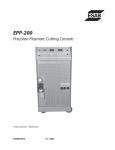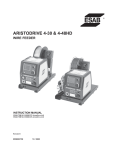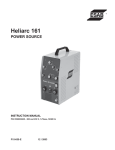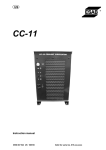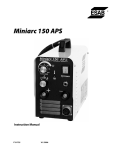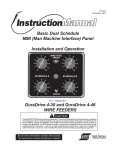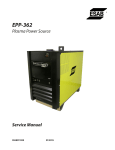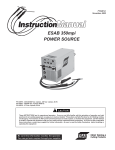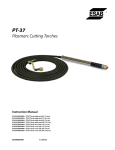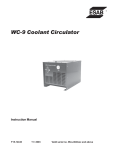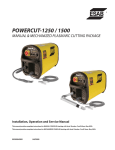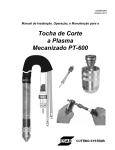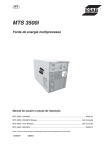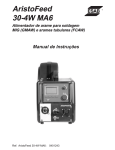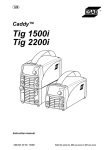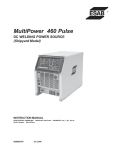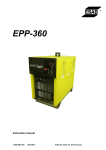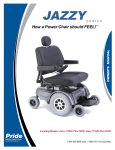Download AristoPower 460 - ESAB Welding & Cutting Products
Transcript
AristoPower 460 DC WELDING POWER SOURCES INSTRUCTION MANUAL This manual provides complete instructions for the following power sources starting with Serial Number MORJ30001, August 2002: ESAB ITEM NO. 0558002668, AristoPower 460 - 230/460/575 vac, 3 ph., 60 Hz Revision B 0558003748 03 / 2004 BE SURE THIS INFORMATION REACHES THE OPERATOR These INSTRUCTIONS are for experienced operators. If you are not fully familiar with the principles of operation and safe practices for arc welding and cutting equipment, we urge you to read our booklet, "Precautions and Safe Practices for Arc Welding, Cutting, and Gouging," Form 52-529. Do NOT permit untrained persons to install, operate, or maintain this equipment. Do NOT attempt to install or operate this equipment until you have read and fully understand these instructions. If you do not fully understand these instructions, contact your supplier for further information. Be sure to read the Safety Precautions before installing or operating this equipment. USER RESPONSIBILITY This equipment will perform in conformity with the description thereof contained in this manual and accompanying labels and/or inserts when installed, operated, maintained and repaired in accordance with the instructions provided. This equipment must be checked periodically. Malfunctioning or poorly maintained equipment should not be used. Parts that are broken, missing, worn, distorted or contaminated should be replaced immediately. Should such repair or replacement become necessary, the manufacturer recommends that a telephone or written request for service advice be made to the Authorized Distributor from whom it was purchased. This equipment or any of its parts should not be altered without the prior written approval of the manufacturer. The user of this equipment shall have the sole responsibility for any malfunction which results from improper use, faulty maintenance, damage, improper repair or alteration by anyone other than the manufacturer or a service facility designated by the manufacturer. Copies of this manual can be obtained by any of the following; Contacting your local ESAB supplier. Downloading a copy from the ESAB web site at www.esabna.com Sending a written request to ESAB WELDING & CUTTING PRODUCTS ATTN: LITERATURE DEPT. 411 S EBENEZER ROAD FLORENCE SC 29501 2 TABLE OF CONTENTS SECTION TITLE PAGE SECTION 1 SAFETY .............................................................................................................................................. 4 SECTION 2 DESCRIPTION ................................................................................................................................... 10 SECTION 3 INSTALLATION .................................................................................................................................. 16 SECTION 4 OPERATION ...................................................................................................................................... 20 SECTION 5 MAINTENANCE ................................................................................................................................. 21 SECTION 6 TROUBLESHOOTING ....................................................................................................................... 22 SECTION 7 REPLACEMENT PARTS ................................................................................................................... 27 3 SECTION 1 SAFETY PRECAUTIONS WARNING: These Safety Precautions are for your protection. They summarize precautionary information from the references listed in Additional Safety Information section. Before performing any installation or operating procedures, be sure to read and follow the safety precautions listed below as well as all other manuals, material safety data sheets, labels, etc. Failure to observe Safety Precautions can result in injury or death. 5. Do not use equipment beyond its ratings. For example, overloaded welding cable can overheat and create a fire hazard. 6. After completing operations, inspect the work area to make certain there are no hot sparks or hot metal which could cause a later fire. Use fire watchers when necessary. 7. For additional information, refer to NFPA Standard 51B, "Fire Prevention in Use of Cutting and Welding Processes", available from the National Fire Protection Association, Batterymarch Park, Quincy, MA 02269. PROTECT YOURSELF AND OTHERS -Some welding, cutting, and gouging processes are noisy and require ear protection. The arc, like the sun, emits ultraviolet (UV) and other radiation and can injure skin and eyes. Hot metal can cause burns. Training in the proper use of the processes and equipment is essential to prevent accidents. Therefore: ELECTRICAL SHOCK -- Contact with live electrical parts and ground can cause severe injury or death. DO NOT use AC welding current in damp areas, if movement is confined, or if there is danger of falling. 1. Be sure the power source frame (chassis) is connected to the ground system of the input power. 2. Connect the workpiece to a good electrical ground. 3. Connect the work cable to the workpiece. A poor or missing connection can expose you or others to a fatal shock. 4. Use well-maintained equipment. Replace worn or damaged cables. 5. Keep everything dry, including clothing, work area, cables, torch/electrode holder, and power source. 6. Make sure that all parts of your body are insulated from work and from ground. 7. Do not stand directly on metal or the earth while working in tight quarters or a damp area; stand on dry boards or an insulating platform and wear rubber-soled shoes. 8. Put on dry, hole-free gloves before turning on the power. 9. Turn off the power before removing your gloves. 10. Refer to ANSI/ASC Standard Z49.1 (listed on next page) for specific grounding recommendations. Do not mistake the work lead for a ground cable. 1. Always wear safety glasses with side shields in any work area, even if welding helmets, face shields, and goggles are also required. 2. Use a face shield fitted with the correct filter and cover plates to protect your eyes, face, neck, and ears from sparks and rays of the arc when operating or observing operations. Warn bystanders not to watch the arc and not to expose themselves to the rays of the electric-arc or hot metal. 3. Wear flameproof gauntlet type gloves, heavy long-sleeve shirt, cuffless trousers, high-topped shoes, and a welding helmet or cap for hair protection, to protect against arc rays and hot sparks or hot metal. A flameproof apron may also be desirable as protection against radiated heat and sparks. 4. Hot sparks or metal can lodge in rolled up sleeves, trouser cuffs, or pockets. Sleeves and collars should be kept buttoned, and open pockets eliminated from the front of clothing 5. Protect other personnel from arc rays and hot sparks with a suitable non-flammable partition or curtains. 6. Use goggles over safety glasses when chipping slag or grinding. Chipped slag may be hot and can fly far. Bystanders should also wear goggles over safety glasses. ELECTRIC AND MAGNETIC FIELDS — May be dangerous. Electric current flowing through any conductor causes localized Electric and Magnetic Fields (EMF). Welding and cutting current creates EMF around welding cables and welding machines. Therefore: FIRES AND EXPLOSIONS -- Heat from flames and arcs can start fires. Hot slag or sparks can also cause fires and explosions. Therefore: 1. Remove all combustible materials well away from the work area or cover the materials with a protective nonflammable covering. Combustible materials include wood, cloth, sawdust, liquid and gas fuels, solvents, paints and coatings, paper, etc. 2. Hot sparks or hot metal can fall through cracks or crevices in floors or wall openings and cause a hidden smoldering fire or fires on the floor below. Make certain that such openings are protected from hot sparks and metal.“ 3. Do not weld, cut or perform other hot work until the workpiece has been completely cleaned so that there are no substances on the workpiece which might produce flammable or toxic vapors. Do not do hot work on closed containers. They may explode. 4. Have fire extinguishing equipment handy for instant use, such as a garden hose, water pail, sand bucket, or portable fire extinguisher. Be sure you are trained in its use. 1. Welders having pacemakers should consult their physician before welding. EMF may interfere with some pacemakers. 2. Exposure to EMF may have other health effects which are unknown. 3. Welders should use the following procedures to minimize exposure to EMF: A. Route the electrode and work cables together. Secure them with tape when possible. B. Never coil the torch or work cable around your body. C. Do not place your body between the torch and work cables. Route cables on the same side of your body. D. Connect the work cable to the workpiece as close as possible to the area being welded. E. Keep welding power source and cables as far away from your body as possible. 4 SECTION 1 SAFETY PRECAUTIONS EQUIPMENT MAINTENANCE -- Faulty or improperly maintained equipment can cause injury or death. Therefore: FUMES AND GASES -- Fumes and gases, can cause discomfort or harm, particularly in confined spaces. Do not breathe fumes and gases. Shielding gases can cause asphyxiation. Therefore: 1. Always have qualified personnel perform the installation, troubleshooting, and maintenance work. Do not perform any electrical work unless you are qualified to perform such work. 2. Before performing any maintenance work inside a power source, disconnect the power source from the incoming electrical power. 3. Maintain cables, grounding wire, connections, power cord, and power supply in safe working order. Do not operate any equipment in faulty condition. 4. Do not abuse any equipment or accessories. Keep equipment away from heat sources such as furnaces, wet conditions such as water puddles, oil or grease, corrosive atmospheres and inclement weather. 5. Keep all safety devices and cabinet covers in position and in good repair. 6. Use equipment only for its intended purpose. Do not modify it in any manner. 1. Always provide adequate ventilation in the work area by natural or mechanical means. Do not weld, cut, or gouge on materials such as galvanized steel, stainless steel, copper, zinc, lead, beryllium, or cadmium unless positive mechanical ventilation is provided. Do not breathe fumes from these materials. 2. Do not operate near degreasing and spraying operations. The heat or arc rays can react with chlorinated hydrocarbon vapors to form phosgene, a highly toxic gas, and other irritant gases. 3. If you develop momentary eye, nose, or throat irritation while operating, this is an indication that ventilation is not adequate. Stop work and take necessary steps to improve ventilation in the work area. Do not continue to operate if physical discomfort persists. 4. Refer to ANSI/ASC Standard Z49.1 (see listing below) for specific ventilation recommendations. 5. WARNING: This product, when used for welding or cutting, produces fumes or gases which contain chemicals known to the State of California to cause birth defects and, in some cases, cancer. (California Health & Safety Code §25249.5 et seq.) ADDITIONAL SAFETY INFORMATION -- For more information on safe practices for electric arc welding and cutting equipment, ask your supplier for a copy of "Precautions and Safe Practices for Arc Welding, Cutting and Gouging", Form 52-529. The following publications, which are available from the American Welding Society, 550 N.W. LeJuene Road, Miami, FL 33126, are recommended to you: 1. ANSI/ASC Z49.1 - "Safety in Welding and Cutting" 2. AWS C5.1 - "Recommended Practices for Plasma Arc Welding" 3. AWS C5.2 - "Recommended Practices for Plasma Arc Cutting" 4. AWS C5.3 - "Recommended Practices for Air Carbon Arc Gouging and Cutting" 5. AWS C5.5 - "Recommended Practices for Gas Tungsten Arc Welding“ 6. AWS C5.6 - "Recommended Practices for Gas Metal Arc Welding"“ 7. AWS SP - "Safe Practices" - Reprint, Welding Handbook. 8. ANSI/AWS F4.1, "Recommended Safe Practices for Welding and Cutting of Containers That Have Held Hazardous Substances." CYLINDER HANDLING -- Cylinders, if mishandled, can rupture and violently release gas. Sudden rupture of cylinder, valve, or relief device can injure or kill. Therefore: 1. Use the proper gas for the process and use the proper pressure reducing regulator designed to operate from the compressed gas cylinder. Do not use adaptors. Maintain hoses and fittings in good condition. Follow manufacturer's operating instructions for mounting regulator to a compressed gas cylinder. 2. Always secure cylinders in an upright position by chain or strap to suitable hand trucks, undercarriages, benches, walls, post, or racks. Never secure cylinders to work tables or fixtures where they may become part of an electrical circuit. 3. When not in use, keep cylinder valves closed. Have valve protection cap in place if regulator is not connected. Secure and move cylinders by using suitable hand trucks. Avoid rough handling of cylinders. 4. Locate cylinders away from heat, sparks, and flames. Never strike an arc on a cylinder. 5. For additional information, refer to CGA Standard P-1, "Precautions for Safe Handling of Compressed Gases in Cylinders", which is available from Compressed Gas Association, 1235 Jefferson Davis Highway, Arlington, VA 22202. MEANING OF SYMBOLS - As used throughout this manual: Means Attention! Be Alert! Your safety is involved. Means immediate hazards which, if not avoided, will result in immediate, serious personal injury or loss of life. Means potential hazards which could result in personal injury or loss of life. Means hazards which could result in minor personal injury. 5 SECTION 1 PRECAUCION DE SEGURIDAD el calor causado por cable sobrecarga en los cables de soldar pueden ocasionar un fuego. 6. Después de termirar la operación del equipo, inspeccione el área de trabajo para cerciorarse de que las chispas o metal caliente ocasionen un fuego más tarde. Tenga personal asignado para vigilar si es necesario. 7. Para información adicional , haga referencia a la publicación NFPA Standard 51B, "Fire Prevention in Use of Cutting and Welding Processes", disponible a través de la National Fire Protection Association, Batterymarch Park, Quincy, MA 02269. ADVERTENCIA: Estas Precauciones de Seguridad son para su protección. Ellas hacen resumen de información proveniente de las referencias listadas en la sección "Información Adicional Sobre La Seguridad". Antes de hacer cualquier instalación o procedimiento de operación , asegúrese de leer y seguir las precauciones de seguridad listadas a continuación así como también todo manual, hoja de datos de seguridad del material, calcomanias, etc. El no observar las Precauciones de Seguridad puede resultar en daño a la persona o muerte. PROTEJASE USTED Y A LOS DEMAS-Algunos procesos de soldadura, corte y ranurado son ruidosos y requiren protección para los oídos. El arco, como el sol , emite rayos ultravioleta (UV) y otras radiaciones que pueden dañar la piel y los ojos. El metal caliente causa quemaduras. EL entrenamiento en el uso propio de los equipos y sus procesos es esencial para prevenir accidentes. Por lo tanto: CHOQUE 1. Asegúrese de que el chasis de la fuente de poder esté conectado 1. Utilice gafas de seguridad con protección a los lados siempre 2. 3. 4. 5. 6. a tierra através del sistema de electricidad primario. 2. Conecte la pieza de trabajo a un buen sistema de tierra física. 3. Conecte el cable de retorno a la pieza de trabajo. Cables y conductores expuestos o con malas conexiones pueden exponer al operador u otras personas a un choque eléctrico fatal. 4. Use el equipo solamente si está en buenas condiciones. Reemplaze cables rotos, dañados o con conductores expuestos. 5. Mantenga todo seco, incluyendo su ropa, el área de trabajo, los cables, antorchas, pinza del electrodo, y la fuente de poder. 6. Asegúrese que todas las partes de su cuerpo están insuladas de ambos, la pieza de trabajo y tierra. 7. No se pare directamente sobre metal o tierra mientras trabaja en lugares estrechos o áreas húmedas; trabaje sobre un pedazo de madera seco o una plataforma insulada y use zapatos con suela de goma. 8. Use guantes secos y sin agujeros antes de energizar el equipo. 9. Apage el equipo antes de quitarse sus guantes. 10. Use como referencia la publicación ANSI/ASC Standard Z49.1 (listado en la próxima página) para recomendaciones específicas de como conectar el equipo a tierra. No confunda el cable de soldar a la pieza de trabajo con el cable a tierra. que esté en el área de trabajo, aún cuando esté usando careta de soldar, protector para su cara u otro tipo de protección. Use una careta que tenga el filtro correcto y lente para proteger sus ojos, cara, cuello, y oídos de las chispas y rayos del arco cuando se esté operando y observando las operaciones. Alerte a todas las personas cercanas de no mirar el arco y no exponerse a los rayos del arco eléctrico o el metal fundido. Use guantes de cuero a prueba de fuego, camisa pesada de mangas largas, pantalón de ruedo liso, zapato alto al tobillo, y careta de soldar con capucha para el pelo, para proteger el cuerpo de los rayos y chispas calientes provenientes del metal fundido. En ocaciones un delantal a prueba de fuego es necesario para protegerse del calor radiado y las chispas. Chispas y partículas de metal caliente puede alojarse en las mangas enrolladas de la camisa , el ruedo del pantalón o los bolsillos. Mangas y cuellos deberán mantenerse abotonados, bolsillos al frente de la camisa deberán ser cerrados o eliminados. Proteja a otras personas de los rayos del arco y chispas calientes con una cortina adecuada no-flamable como división. Use careta protectora además de sus gafas de seguridad cuando esté removiendo escoria o puliendo. La escoria puede estar caliente y desprenderse con velocidad. Personas cercanas deberán usar gafas de seguridad y careta protectora. CAMPOS ELECTRICOS Y MAGNETICOS - Son peligrosos. La corriente eléctrica fluye através de cualquier conductor causando a nivel local Campos Eléctricos y Magnéticos (EMF). Las corrientes en el área de corte y soldadura, crean EMF alrrededor de los cables de soldar y las maquinas. Por lo tanto: 1. Soldadores u Operadores que use marca- FUEGO Y EXPLOSIONES -- El calor de las flamas y el arco pueden ocacionar fuegos. Escoria caliente y las chispas pueden causar fuegos y explosiones. Por lo tanto: 1. Remueva todo material combustible lejos del área de trabajo o 2. 3. 4. 5. ELECTRICO -- El contacto con las partes eléctricas energizadas y tierra puede causar daño severo o muerte. NO use soldadura de corriente alterna (AC) en áreas húmedas, de movimiento confinado en lugares estrechos o si hay posibilidad de caer al suelo. pasos para el corazón deberán consultar a su médico antes de soldar. El Campo Electromagnético (EMF) puede interferir con algunos marca-pasos. 2. Exponerse a campos electromagnéticos (EMF) puede causar otros efectos de salud aún desconocidos. 3. Los soldadores deberán usar los siguientes procedimientos para minimizar exponerse al EMF: A. Mantenga el electrodo y el cable a la pieza de trabajo juntos, hasta llegar a la pieza que usted quiere soldar. Asegúrelos uno junto al otro con cinta adhesiva cuando sea posible. B. Nunca envuelva los cables de soldar alrededor de su cuerpo. C. Nunca ubique su cuerpo entre la antorcha y el cable, a la pieza de trabajo. Mantega los cables a un sólo lado de su cuerpo. D. Conecte el cable de trabajo a la pieza de trabajo lo más cercano posible al área de la soldadura. E. Mantenga la fuente de poder y los cables de soldar lo más lejos posible de su cuerpo. cubra los materiales con una cobija a prueba de fuego. Materiales combustibles incluyen madera, ropa, líquidos y gases flamables, solventes, pinturas, papel, etc. Chispas y partículas de metal pueden introducirse en las grietas y agujeros de pisos y paredes causando fuegos escondidos en otros niveles o espacios. Asegúrese de que toda grieta y agujero esté cubierto para proteger lugares adyacentes contra fuegos. No corte, suelde o haga cualquier otro trabajo relacionado hasta que la pieza de trabajo esté totalmente limpia y libre de substancias que puedan producir gases inflamables o vapores tóxicos. No trabaje dentro o fuera de contenedores o tanques cerrados. Estos pueden explotar si contienen vapores inflamables. Tenga siempre a la mano equipo extintor de fuego para uso instantáneo, como por ejemplo una manguera con agua, cubeta con agua, cubeta con arena, o extintor portátil. Asegúrese que usted esta entrenado para su uso. No use el equipo fuera de su rango de operación. Por ejemplo, 6 SECTION 1 PRECAUCION DE SEGURIDAD MANTENIMIENTO DEL EQUIPO -- Equipo defectuoso o mal mantenido puede causar daño o muerte. Por lo tanto: HUMO Y GASES -- El humo y los gases, pueden causar malestar o daño, particularmente en espacios sin ventilación. No inhale el humo o gases. El gas de protección puede causar falta de oxígeno. Por lo tanto: 1. Siempre tenga personal cualificado para efectuar l a instalación, diagnóstico, y mantenimiento del equipo. No ejecute ningún trabajo eléctrico a menos que usted esté cualificado para hacer el trabajo. 2. Antes de dar mantenimiento en el interior de la fuente de poder, desconecte la fuente de poder del suministro de electricidad primaria. 3. Mantenga los cables, cable a tierra, conexciones, cable primario, y cualquier otra fuente de poder en buen estado operacional. No opere ningún equipo en malas condiciones. 4. No abuse del equipo y sus accesorios. Mantenga el equipo lejos de cosas que generen calor como hornos, también lugares húmedos como charcos de agua , aceite o grasa, atmósferas corrosivas y las inclemencias del tiempo. 5. Mantenga todos los artículos de seguridad y coverturas del equipo en su posición y en buenas condiciones. 6. Use el equipo sólo para el propósito que fue diseñado. No modifique el equipo en ninguna manera. 1. Siempre provea ventilación adecuada en el área de trabajo por medio natural o mecánico. No solde, corte, o ranure materiales con hierro galvanizado, acero inoxidable, cobre, zinc, plomo, berílio, o cadmio a menos que provea ventilación mecánica positiva . No respire los gases producidos por estos materiales. 2. No opere cerca de lugares donde se aplique substancias químicas en aerosol. El calor de los rayos del arco pueden reaccionar con los vapores de hidrocarburo clorinado para formar un fosfógeno, o gas tóxico, y otros irritant es. 3. Si momentáneamente desarrolla inrritación de ojos, nariz o garganta mientras est á operando, es indicación de que la ventilación no es apropiada. Pare de trabajar y tome las medidas necesarias para mejorar la ventilación en el área de trabajo. No continúe operando si el malestar físico persiste. 4. Haga referencia a la publicación ANSI/ASC Standard Z49.1 (Vea la lista a continuación) para recomendaciones específicas en la ventilación. 5. ADVERTENCIA-- Este producto cuando se utiliza para soldaduras o cortes, produce humos o gases, los cuales contienen químicos conocidos por el Estado de California de causar defectos en el nacimiento, o en algunos casos, Cancer. (California Health & Safety Code §25249.5 et seq.) INFORMACION ADICIONAL DE SEGURIDAD -Para más información sobre las prácticas de seguridad de los equipos de arco eléctrico para soldar y cortar, pregunte a su suplidor por una copia de "Precautions and Safe Practices for Arc Welding, Cutting and Gouging-Form 52-529. Las siguientes publicaciones, disponibles através de la American Welding Society, 550 N.W. LeJuene Road, Miami, FL 33126, son recomendadas para usted: 1. ANSI/ASC Z49.1 - "Safety in Welding and Cutting" 2. AWS C5.1 - "Recommended Practices for Plasma Arc Welding" 3. AWS C5.2 - "Recommended Practices for Plasma Arc Cutting" 4. AWS C5.3 - "Recommended Practices for Air Carbon Arc Gouging and Cutting" 5. AWS C5.5 - "Recommended Practices for Gas Tungsten Arc Welding“ 6. AWS C5.6 - "Recommended Practices for Gas Metal Arc Welding"“ 7. AWS SP - "Safe Practices" - Reprint, Welding Handbook. 8. ANSI/AWS F4.1, "Recommended Safe Practices for Welding and Cutting of Containers That Have Held Hazardous Substances." SIGNIFICADO DE LOS SIMBOLOS -Según usted avanza en la lectura de este folleto: Los Símbolos Significan ¡Atención! ¡Esté Alerta! Se trata de su seguridad. Significa riesgo inmediato que, de no ser evadido, puede resultar inmediatamente en serio daño personal o la muerte. MANEJO DE CILINDROS-- Los cilindros, si no son manejados correctamente, pueden romperse y liberar violentamente gases. Rotura repentina del cilindro, válvula, o válvula de escape puede causar daño o muerte. Por lo tanto: 1. Utilize el gas apropiado para el proceso y utilize un regulador diseñado para operar y reducir la presión del cilindro de gas . No utilice adaptadores. Mantenga las mangueras y las conexiones en buenas condiciones. Observe las instrucciones de operación del manufacturero para montar el regulador en el cilindro de gas comprimido. 2. Asegure siempre los cilindros en posición vertical y amárrelos con una correa o cadena adecuada para asegurar el cilindro al carro, transportes, tablilleros, paredes, postes, o armazón. Nunca asegure los cilindros a la mesa de trabajo o las piezas que son parte del circuito de soldadura . Este puede ser parte del circuito elélectrico. 3. Cuando el cilindro no está en uso, mantenga la válvula del cilindro cerrada. Ponga el capote de protección sobre la válvula si el regulador no está conectado. Asegure y mueva los cilindros utilizando un carro o transporte adecuado. Evite el manejo brusco de los Significa el riesgo de un peligro potencial que puede resultar en serio daño personal o la muerte. Significa el posible riesgo que puede resultar en menores daños a la persona. 7 SECTION 1 PRÉCAUTIONS DE SÉCURITÉ a. Éloigner suffisamment tous les matériaux combustibles du secteur où l’on exécute des soudures ou des coupes à l’arc, à moins de les recouvrir complètement d’une bâche non-inflammable. Ce type de matériaux comprend notamment le bois, les vêtements, la sciure, l’essence, le kérosène, les peintures, les solvants, le gaz naturel, l’acétylène, le propane et autres substances combustibles semblables. b. Les étincelles ou les projections de métal incandescent peuvent tomber dans des fissures du plancher ou dans des ouvertures des murs et y déclencher une ignition lente cachée. Veiller à protéger ces ouvertures des étincelles et des projections de métal. c. N’exécutez pas de soudures, de coupes, d’opérations de gougeage ou autres travaux à chaud à la surface de barils, bidons, réservoirs ou autres contenants usagés, avant de les avoir nettoyés de toute trace de substance susceptible de produire des vapeurs inflammables ou toxiques. d. En vue d’assurer la prévention des incendies, il convient de disposer d’un matériel d’extinction prêt à servir immédiatement, tel qu’un tuyau d’arrosage, un seau à eau, un seau de sable ou un extincteur portatif. e. Une fois le travail à l’arc terminé, inspectez le secteur de façon à vous assurer qu’aucune étincelle ou projection de métal incandescent ne risque de provoquer ultérieurement un feu. 3. CHOC ÉLECTRIQUE-- Le gougeage à l’arc et à l’arc au plasma exige l’emploi de tensions à vide relativement importantes; or, celles-ci risquent de causer des dommages corporels graves et même mortels en cas d’utilisation inadéquate. La gravité du choc électrique reçu dépend du chemin suivi par le courant à travers le corps humain et de son intensité. a. Ne laissez jamais de surfaces métalliques sous tension venir au contact direct de la peau ou de vêtements humides. Veillez à porter des gants bien secs. b. Si vous devez effectuer un travail sur une surface métallique ou dans un secteur humide, veillez à assu-rer votre isolation corporelle en portant des gants secs et des chaussures à semelles de caoutchouc et en vous tenant sur une planche ou une plate-forme sèche. c. Mettez toujours à la terre le poste de soudage/coupage en le reliant par un câble à une bonne prise de terre. d. N’utilisez jamais de câbles usés ou endommagés. Ne surchargez jamais le câble. Utilisez toujours un équipement correctement entretenu. e. Mettez l’équipement hors tension lorsqu’il n’est pas en service. une mise à la masse accidentelle peut en effet provoquer une surchauffe de l’équipement et un danger d’incendie. Ne pas enrouler ou passer le câble autour d’une partie quelconque du corps. f. Vérifiez si le câble de masse est bien relié à la pièce en un point aussi proche que possible de la zone de travail. Le branchement des câbles de masse à l’ossature du bâtiment ou en un point éloigné de la zone de travail augmente en effet le risque de passage d’un courant de sortie par des chaînes de AVERTISSEMENT: Ces règles de sécurité ont pour objet d’ assurer votre protection. Veillez à lire et à observer les précautions énoncées ci-dessous avant de monter l’ équipement ou de commercer à l’utiliser. Tout défaut d’observation de ces précautions risque d’entraîner des blessures graves ou mortelles. 1. PROTECTION INDIVIDUELLE-- Les brûlures de la peau et des yeux dues au rayonnement de l’arc électrique ou du métal incandescent, lors du soudage au plasma ou à l’électrode ou lors du gougeage à l’arc, peuvent s’avérer plus graves que celles résultant d’une exposition prolongée au soleil. Aussi convient-il d’observer les précautions suivantes: a. Portez un écran facial adéquat muni des plaques protectrices et des verres filtrants appropriés afin de vous protéger les yeux, le visage, le cou et les oreilles des étincelles et du rayonnement de l’arc électrique lorsque vous effectuez des soudures ou des coupes ou lorsque vous en observez l’exécution. AVERTISSEZ les personnes se trouvant à proximité de façon à ce qu’elles ne regardent pas l’arc et à ce qu’elles ne s’exposent pas à son rayonnement, ni à celui du métal incandescent. b. Portez des gants ignifugés à crispins, une tunique épaisse à manches longues, des pantalons sans rebord, des chaussures à embout d’acier et un casque de soudage ou une calotte de protection, afin d’éviter d’exposer la peau au rayonnement de l’arc électrique ou du métal incandescent. ll est également souhaitable d’utiliser un tablier ininflammable de façon à se protéger des étincelles et du rayonnement thermique. c. Les étincelles ou les projections de métal incandescent risquent de se loger dans des manches retroussées, des bords relevés de pantalons ou dans des poches. Aussi convient-il de garder boutonnés le col et les manches et de porter des vêtements sans poches à l’avant. d. Protégez des étincelles et du rayonnement de l’arc électrique les autres personnes travaillant à proximité à l’aide d’un écran ininflammable adéquat. e. Ne jamais omettre de porter des lunettes de sécurité lorsque vous vous trouvez dans un secteur où l’on effectue des opérations de soudage ou de coupage à l’arc. Utilisez des lunettes de sécurité à écrans ou verres latéraux pour piquer ou meûler le laitier. Les piquetures incandescentes de laitier peuvent être projetées à des distances considérables. Les personnes se trouvant à proximité doivent également porter des lunettes de protection. f. Le gougeage à l’arc et le soudage à l’arc au plasma produisent un niveau de bruit extrêmement élevé (de 100 à 114 dB) et exigent par conséquent l’emploi de dispositifs appropriés de protection auditive. 2 PRÉVENTION DES INCENDES-- Les projections de laitier incandescent ou d’étincelles peuvent provoquer de graves incendies au contact de matériaux combustibles solides, liquides ou gazeux. Aussi faut-il observer les précautions suivantes: 8 SECTION 1 PRÉCAUTIONS DE SÉCURITÉ a. Éloigner suffisamment tous les matériaux combustibles du secteur où l’on exécute des soudures ou des coupes à l’arc, à moins de les recouvrir complètement d’une bâche non-inflammable. Ce type de matériaux comprend notamment le bois, les vêtements, la sciure, l’essence, le kérosène, les peintures, les solvants, le gaz naturel, l’acétylène, le propane et autres substances combustibles semblables. b. Les étincelles ou les projections de métal incandescent peuvent tomber dans des fissures du plancher ou dans des ouvertures des murs et y déclencher une ignition lente cachée. Veiller à protéger ces ouvertures des étincelles et des projections de métal. c. N’exécutez pas de soudures, de coupes, d’opérations de gougeage ou autres travaux à chaud à la surface de barils, bidons, réservoirs ou autres contenants usagés, avant de les avoir nettoyés de toute trace de substance susceptible de produire des vapeurs inflammables ou toxiques. d. En vue d’assurer la prévention des incendies, il convient de disposer d’un matériel d’extinction prêt à servir immédiatement, tel qu’un tuyau d’arrosage, un seau à eau, un seau de sable ou un extincteur portatif. e. Une fois le travail à l’arc terminé, inspectez le secteur de façon à vous assurer qu’aucune étincelle ou projection de métal incandescent ne risque de provoquer ultérieurement un feu. 3. CHOC ÉLECTRIQUE-- Le gougeage à l’arc et à l’arc au plasma exige l’emploi de tensions à vide relativement importantes; or, celles-ci risquent de causer des dommages corporels graves et même mortels en cas d’utilisation inadéquate. La gravité du choc électrique reçu dépend du chemin suivi par le courant à travers le corps humain et de son intensité. a. Ne laissez jamais de surfaces métalliques sous tension venir au contact direct de la peau ou de vêtements humides. Veillez à porter des gants bien secs. b. Si vous devez effectuer un travail sur une surface métallique ou dans un secteur humide, veillez à assu-rer votre isolation corporelle en portant des gants secs et des chaussures à semelles de caoutchouc et en vous tenant sur une planche ou une plate-forme sèche. c. Mettez toujours à la terre le poste de soudage/coupage en le reliant par un câble à une bonne prise de terre. d. N’utilisez jamais de câbles usés ou endommagés. Ne surchargez jamais le câble. Utilisez toujours un équipement correctement entretenu. e. Mettez l’équipement hors tension lorsqu’il n’est pas en service. une mise à la masse accidentelle peut en effet provoquer une surchauffe de l’équipement et un danger d’incendie. Ne pas enrouler ou passer le câble autour d’une partie quelconque du corps. f. Vérifiez si le câble de masse est bien relié à la pièce en un point aussi proche que possible de la zone de travail. Le branchement des câbles de masse à l’ossature du bâtiment ou en un point éloigné de la zone de travail augmente en effet le risque de passage d’un courant de sortie par des chaînes de AVERTISSEMENT: Ces règles de sécurité ont pour objet d’ assurer votre protection. Veillez à lire et à observer les précautions énoncées ci-dessous avant de monter l’ équipement ou de commercer à l’utiliser. Tout défaut d’observation de ces précautions risque d’entraîner des blessures graves ou mortelles. 1. PROTECTION INDIVIDUELLE-- Les brûlures de la peau et des yeux dues au rayonnement de l’arc électrique ou du métal incandescent, lors du soudage au plasma ou à l’électrode ou lors du gougeage à l’arc, peuvent s’avérer plus graves que celles résultant d’une exposition prolongée au soleil. Aussi convient-il d’observer les précautions suivantes: a. Portez un écran facial adéquat muni des plaques protectrices et des verres filtrants appropriés afin de vous protéger les yeux, le visage, le cou et les oreilles des étincelles et du rayonnement de l’arc électrique lorsque vous effectuez des soudures ou des coupes ou lorsque vous en observez l’exécution. AVERTISSEZ les personnes se trouvant à proximité de façon à ce qu’elles ne regardent pas l’arc et à ce qu’elles ne s’exposent pas à son rayonnement, ni à celui du métal incandescent. b. Portez des gants ignifugés à crispins, une tunique épaisse à manches longues, des pantalons sans rebord, des chaussures à embout d’acier et un casque de soudage ou une calotte de protection, afin d’éviter d’exposer la peau au rayonnement de l’arc électrique ou du métal incandescent. ll est également souhaitable d’utiliser un tablier ininflammable de façon à se protéger des étincelles et du rayonnement thermique. c. Les étincelles ou les projections de métal incandescent risquent de se loger dans des manches retroussées, des bords relevés de pantalons ou dans des poches. Aussi convient-il de garder boutonnés le col et les manches et de porter des vêtements sans poches à l’avant. d. Protégez des étincelles et du rayonnement de l’arc électrique les autres personnes travaillant à proximité à l’aide d’un écran ininflammable adéquat. e. Ne jamais omettre de porter des lunettes de sécurité lorsque vous vous trouvez dans un secteur où l’on effectue des opérations de soudage ou de coupage à l’arc. Utilisez des lunettes de sécurité à écrans ou verres latéraux pour piquer ou meûler le laitier. Les piquetures incandescentes de laitier peuvent être projetées à des distances considérables. Les personnes se trouvant à proximité doivent également porter des lunettes de protection. f. Le gougeage à l’arc et le soudage à l’arc au plasma produisent un niveau de bruit extrêmement élevé (de 100 à 114 dB) et exigent par conséquent l’emploi de dispositifs appropriés de protection auditive. 2 PRÉVENTION DES INCENDES-- Les projections de laitier incandescent ou d’étincelles peuvent provoquer de graves incendies au contact de matériaux combustibles solides, liquides ou gazeux. Aussi faut-il observer les précautions suivantes: 9 SECTION 2 DESCRIPTION AristoPower 460 Power Source Easy-to-use advanced technology Customizable MA-6 man/machine communications. Upgradable using ESAT software (ESAB Software Administration Tools). 107 preprogrammed synergic welding programs for standard & pulsed Mig and Stick welding 10 memory locations for user-defined welding parameter storage Digital preset of voltage, amperage or wire speed on process slection. Robust, reliable, energy saving 450 amp/100% Duty Cycle power source SuperSwitchTM Technology design, provides superior inverter like performance in the welding arc while providing SCR like reliability. Energy and power efficient, the best in its class with a 92% efficiency figure. Saves energy and reduces power costs. Uses up to 50% less current than conventional SCR machines. True Multi-process, three phase power source designed for heavy duty Industrial DC welding applications. Use for High Performance Mig, Pulse Mig, Flux Cored wire, Stick electrode welding, and Air Carbon Arc Gouging Variable inductance for fine tuning of the arc characteristics when short arc welding. Adjustable arc force and hot start control for superior stick electrode performance. 100% Solid State, no mechanical contactor Sheet metal parts and hardware made of stainless steel. Top and side panel made of Kydex polymer for superior durability in harsh environments. Auto Fan feature standard in the unit for energy savings. Automatically turns the fan motor on and off. Convenient 115vac auxiliary power receptacle. Compatible with AristoDrive 4-30 and AristoDrive 4-48 wire feeders. NAS (Tweco) style Quick Disconnect gun-to-feeder connection is standard Shown with AristoDrive 4 -30 wire feeder, GM-400 Mig welding torch, TR-29 truck kit, work cable, clamp and welding wire. Specifications: Rated DC Output @ 100% Duty Cycle 50/60Hz, cv or cc .............................. .450 amps 38 vdc Rated DC Output @ 60% Duty Cycle 50/60Hz, cv or cc ............................... 500 amps 39 vdc Welding Range ................................... 10A/12V to 500A/40V Open Circuit Voltage Max. .......................................... 80vdc Primary Input Voltage and Current @ 100% DutyCycle 230/460/575vac, 60Hz 3ph .................... 66/33/26 amps Power Factor at Rated Output ...................................... 89% Efficiency at Rated Output ............................................ 92% Auxiliary Output Power ................ 115vac 50/60Hz, 10 amps Physical Dimensions: W x L x H ......... 18.8”(483mm), 32.5” (819mm), 25”(622mm) Net Weight ................................................. 322 lbs.(146 Kg) Shipping Weight ......................................... 375 lbs. (170Kg) Build a Custom AristoPower Welding System AristoPow er TM Pow er Source AristoPow er-460 0558002668 AristoDrive 4TM Wire Feeder AristoDrive 4-30 * 0558003276 AristoDrive 4-48 * 0558003275 AristoDrive 4-48 * Connection Cable Boom System 6ft. (2m) 0456527880 26ft. (8m) 0456527881 52ft. (16m) 0558003700 Balance Boom** 0456527882 82ft. (25m) Gunmaster 400 NAS Connection Balance Boom 12ft. 0456527883 12 ft. x .035-.045 0558001656 15 ft. x .035-.045 0558001659 12 ft. x .052-1/16 0558001657 15 ft. x .052-1/16 0558003442 114ft. (35m) 0558001660 Balance Boom 16ft. 0456527884 0558003365 Options & Accessories Complete Your Custom System by Ordering Components from the Options & Accessories List on the follow ing page * Includes M A -6 M M C ** See Bo o m Sales Sheets fo r co mplete info rmatio n 10 SECTION 2 DESCRIPTION MMA-6 MMC (Man/Machine Communications) Easy to set weld parameters for MIG, MIG Pulse, Stick or Gouging. Choose synergic weld parameters from of 107 possibilities. Set the wire feed speed and weld! Internal Memory stores up to 10 different weld parameter set-ups. Recall parameters with a simple push of a button. Programmable soft keys allow direct access to flexible functions, such as hot start, crater fill, 2/4 stroke trigger, wire inch, gas purge, etc. Large display gives real time readout of voltage, current, and wire speed. Preset inductance, gas pre & post flow, inch or metric units, auto weld schedule select, arc force, burnback and more. Update and change weld data using optional ESAT software for maximum flexibility. Options & Accessories Aristo Control 5 Program Box ............................ 466801881 Use this option to access 5 different weld schedules saved to memory locations 1 through 5. Arc trim is remotely controlled from the box. AristoPower-460 TR-29 Truck ............................................................... 37924 This truck kit provides complete mobility of the power source. The kit consists of front casters, rear cylinder rack for two cylinders, gas cylinder bracket and chain, and pull handle. Aristo Control 5 Program, Bar ............................ 466515881 The option has the same function as the 5 Program Box yet is more compact and mobile. Wire Feeder Swivel Mount Kit .................................. 36172 This kit allows the wire feeder to be placed on an insulated swivel post on top of the power source. The feeder can freely rotate, minimizing potential wire feed problems. Aristo Synergic Control Box .............................. 466801880 Provides remote control for synergic wire feed speed and voltage trim. ESAT PC Software Package ............................. 0458847880 PC software for service, diaignostics, troubleshooting, and upgrading (PC is not included). Aristo Synergic Control Bar ............................... 466515880 The option has the same function as the Synergic Box yet is more compact and mobile. 11 SECTION 2 DESCRIPTION 2.1. SAFETY Before the AristoPower 460 power source is put into operation, the safety section at the front of this manual should be read completely. This will help avoid possible injury due to misuse or improper installation. The definitions relating to the: safety notations are described at the end of the Safety Section in the front of this manual — read them and their specific text references carefully. 2.2. DESCRIPTION This manual has been prepared for use by an experienced operator. It provides information to familiarize the operator with the design, installation and operation of the AristoPower 460 power source. DO NOT attempt to install or operate this equipment until you have read and fully understand these instructions. The information presented here should be given careful consideration to ensure proper installation and optimum weld performance of this equipment. Table 2-1. Rating Label for AristoPower 460 ESAB WELDING & CUTTING PRODUCTS ARISTOPOWER/ MULTIPOWER 460 3 F1 F2 50A/ 14V - 500A/ 40V U-MAX 80V INPUT 3 COOLING AF 954672-B 60 Hz IP 21 X I2 U2 60% 500A 40A U2 230V 400V 575V I2 76A 38A 31A 100% 450A 38A I2 66A 33A 26A 4/02 The AristoPower 460 power source is a constant current (CC) and constant voltage (CV), three-phase, secondary chopper dc design with solid state contactor and control circuitry. This is a multi-process power source designed to provide the volt-ampere characteristics desired for conventional MIG (GMAW) and flux core (FCAW) arc welding in the CV (constant voltage) mode, Mig Pulse (GMAW-P) arc or stick (SMAW) welding and air carbon arc cutting/gouging (CAC-A) in the CC (constant current) mode. Table 2-1 outlines the electrical and physical specifications. 12 SECTION 2 DESCRIPTION Features • Auto Fan - The AristoPower 460 fan will run when the power source is first powered up and will remain running for 30 seconds then shut down. The fan will start again when welding begins. The fan will remain running for 6.5 minutes after welding stops and then shut down automatically if welding has not continued. • Stainless steel frame for envirornmental durability. • Durable composite side and top panels will not corrode. • 100% duty cycle at 450 amps output. • Upgrade and reconfigure with ESAT (ESAB Software Administration Tool) software. A. VOLT - AMPERE CHARACTERISTICS The curves shown in Figure 2-1 represent the static volt-ampere characteristics for the power source. The slant of these curves is referred to as the "slope" and is generally defined as the voltage drop per 100 amperes of current use. These curves show the output voltage available at any given output current from the minimum to the maximum setting of the voltage/ current control. B. FRONT AND REAR PANEL DESCRIPTION 1. POWER ON/OFF SWITCH & LAMP The main power switch is located on the right front panel of the power source. This switch energizes the main transformer, control circuitry and illuminates the Power “ON” lamp. 90 80 Arc Voltage 70 Constant Current 60 50 Constant Voltage 40 30 Constant Current 20 Constant Voltage 10 0 0 100 200 300 400 500 Weld Current (Amperes) Figure 2-1 - MultiPower 460 Volt-Ampere Curves 13 600 SECTION 2 DESCRIPTION 2. FAULT/TEMPERATURE LAMP The FAULT/TEMP lamp illuminates if an over temperature condition occurs within the AristoPower 460 power source. This condition may be caused by excessive duty cycle or over-current conditions. When an over temperature condition occurs, the welding output is turned off and the unit must be allowed to cool. The machine will automatically reset when the temperature falls to a safe level. 3. CONTROL RECEPTACLE There are two 12-pin receptacles on the front panel and two 12-pin receptacles on the rear panel. Any of the four receptacles accepts the control cable from the AristoDrive wire feeder and handles all the control signals needed for operation. The remaining receptacles are use for remote controls, service and trouble shooting accessories. 4. AUXILIARY 115 VAC RECEPTACLE A 115 Vac receptacle is provided to supply power to accessories such as a water cooler, heated CO2 regulator, or small hand tools. The receptacle is rated 115 Vac / 10 amps with a floating neutral. 5. 42VAC AND 115 VAC CIRCUIT BREAKER (CB1 & CB2) These resetable 10 amp circuit breakers (CB1 & CB2) protect the 42 volt wire feeder/control and 115 volt auxiliary receptacle circuitry against over current. 6. COMPONENT CONNECTION RECEPTACLES There are 2 receptacles on the front panel and 2 on the rear panel for connection of wire feeders, accessories and service monitoring equipment. 7. WELD CABLE CONNECTION LUGS A positive and negative lug connector is provided on the front and a 600A positive "twist lock" connector is mounted on the rear panel. 2.3. OPTIONAL ACCESSORIES A number of remote control units can be connected to the Aristo via the Remote Control Adaptor A. REMOTE PROGRAM AND SYNERGIC CONTROLS (SEE OPTIONS & ACCESSORIES PG. 11) The remote control adapter converts analog signals from the remote control to a digital signal, which is transmitted to the power source. Power “ON” Lamp Fault/Temperature Lamp Figure 2-2. Standard Control Panel 14 SECTION 2 42Vac and 115 Vac Circuit Breakers DESCRIPTION 115 Vac 10 Amp Receptacle OFF/ON Switch Component Connection Receptacles (Secondary) Component Connection Receptacles Weld Cable Connection Lugs Positive Output Receptacle Input Cable Strain Relief Figure 2-3. Front View Figure 2-4. Rear View When the adapter is connected, the power source and wire feed unit is in remote control mode; the buttons on the MMC control (man/machine communications mounted in the wire feeder) are blocked and only adjustment of the voltage and wire feed speed trim is allowed. When a remote control unit is used, the function will be changed to the setting of current during MMA welding. Only one adapter may be connected to the welding system. B. TR-29 TRUCK KIT (PN - 37924) This truck kit provides complete mobility of the power source. The kit consists of front castors, rear cylinder rack and wheels, gas cylinder bracket, cylinder chain and pull handle. C. SWIVEL MOUNT KIT (PN - 36172) This kit allows the wire feeder to be placed on an insulated swivel post on top of the power source. The feeder can freely rotate, relieving potential wire feed problems caused by sharp bends in the gun cable while, at the same time, increasing the radius of the working area. 15 SECTION 3 INSTALLATION 3.1. INSTALLATION A. LOCATION A proper installation site is necessary for the power source to provide dependable service. A proper installation site permits freedom of air movement through the unit while minimizing exposure to dust, dirt, moisture and corrosive vapors. A minimum of 18 inches (46 cm) is required between the side and rear panels of the power source and the nearest obstruction. The selected site should also allow easy removal of the power source outer enclosure for maintenance. See Specifications (pg. 10) for overall dimensions of the unit. B. RECEIVING, UNPACKING AND PLACEMENT Do not use filters on this unit as they would restrict the volume of intake air required for proper cooling. Output ratings on this unit are based on an unobstructed supply of cooling air drawn over its internal components. Warranty is void if any type of filtering device is used. For lifting purposes and for keeping dust, moisture, and other foreign material from entering the power source, the lifting eyebolt must be fully tightened with a tool. When requesting information concerning this equipment, it is essential that Item number, Serial number and Model number of the equipment be supplied. 1. Upon receipt, remove all packing material and carefully inspect for any damage that may have occurred during shipment. Any claims for loss or damage that may have occurred in transit must be filed by the purchaser with the carrier. A copy of the bill of lading and freight bill will be furnished by the carrier on request. 2. Remove the power source from the container. Remove all packing materials. Check the container for any loose parts. 3. Check air passages at front and rear of cabinet, making sure that packing material has not obstructed air flow through the power source. 4. Install the lifting bolt furnished with the power sources into the top of the unit. 5. After selecting an installation site, place the power source in the desired location. The unit may be lifted either by using the lifting bolt or by forklift truck. If a forklift is used for lifting the unit, be sure that the lift forks are long enough to extend completely under the base. C. PRIMARY (INPUT) ELECTRICAL CONNECTION ELECTRIC SHOCK CAN KILL! Before making electrical input connections to the power source, "Machinery Lockout Procedures" should be employed. If the connections are to be made from a line disconnect switch, place the switch in the off position and padlock it to prevent inadvertent tripping. If the connection is made from a fuse box, remove the corresponding fuses and padlock the box cover. If it is not possible to use padlocks, attach a red tag to the line disconnect switch (or fuse box) warning others that the circuit is being worked on. This power source is a three-phase unit and must be connected to a three-phase power supply. It is recommended that the unit be operated on a dedicated circuit to prevent impairment of performance due to an overloaded circuit. 1. The primary power leads must be insulated copper conductors. Three power leads and one ground wire are required. Either rubber covered cable or conduit (flexible or solid) may be used. Table 3-1 provides recommended input conductors and line fuse sizes. 2. Remove the top cover. Identify primary power input connection block, chassis ground lug on the fan shroud frame, and primary input terminal board. Refer to Figures 3-1 thru 3-5. 3. When using the provided strain relief, refer to Figure 3-2 for proper cable strip lengths. It is important to follow the cable strip guide to ensure that if the primary input cable is ever pulled from the strain relief, the input conductors will be pulled from the Terminal Block before the ground lead is pulled from the ground lug. Once stripped, thread the input and ground conductors through the large strain-relief in the rear panel of the power source. Connect the ground wire to the terminal lug located on the fan shroud frame. Connect the primary power leads to terminals L1, L2 and L3 on the input power block. Secure the strain relief on the input cable. 4. Check all connections for proper tightness. Ensure all connections are correct and well-insulated. 16 SECTION 3 INSTALLATION Table 3-1. Recommended Sizes for Input Conductors and Line Fuses Rated Input @ 100% Duty Cycle Volts Amps Input & GND Conductor* CU/AWG 220 230 400 460 575 68 66 37 33 26 No. 6 No. 6 No. 8 No. 8 No. 10 Fuse Size Amps 100 100 60 60 50 *Sized per National Code for 80 °C rated copper conductors @ 30 °C ambient. Not more than three conductors in raceway or cable. Local codes should be followed if they specify sizes other than those listed above. TB-3 L1, L2, L3 Connection Primary Cable (Supplied by Customer) Ground Fault Switch & Bracket Ground Connection Figure 3-1. Primary Power Leads L1,L2, L3 & Ground (3) PRIMARY INPUT CONDUCTORS 5" 24" Green (Earth Ground) Figure 3-2. Recommended Cable Strip Lengths 17 SECTION 3 INSTALLATION 5. Figures 3-3 thru 3-5 illustrate the input voltage terminal board and the input voltage link connections. The particular voltages from which this power source may be operated are stated on the rating plate. The voltage links were factory set for highest voltage stated on the rating plate (575VAC). If the power source is to be operated on another stated input voltage, the links must be reset for that particular input voltage. Always verify the input voltage and check the link arrangement regardless of factory setting. The voltage links are set up by reconfiguring the copper link bars to the silk-screened voltage designations for the desired voltage. 230 Vac Input 460 Vac Input 575 Vac Input Figure 3-3. Input Terminal Board Configuration for 230/460/575 Model (factory supplied in the 575 configuration) * * * 230 Vac Input 460 Vac Input 200 Vac Input 400 Vac Input Figure 3-5. Input Terminal Board Configuration 200/ 400 Model (factory supplied in the 400 configuration) Figure 3-4. Input Terminal Board Configuration 230/ 460 Model (factory supplied in the 460 configuration) 18 SECTION 3 INSTALLATION D. OUTPUT WELDING CONNECTIONS (SECONDARY) Be sure that the branch circuit or main disconnect switch is off, or electrical input fuses are removed, before attempting any inspection or work inside the power source. Placing the power switch in the off position does not remove all power from inside the power source. The output connections are located on the front panel (Figure 2-3). The positive connection is located at the bottom left corner and the negative connection is located at the bottom right corner. An additional (+) twist lock connect is available on the rear panel. In most instances, the work cable is connected to the negative output terminal lug. Table 3-6 provides the recommended secondary cable output sizes. 1. CONNECTIONS FROM THE WIRE FEEDER The wire feeder control cable connects to the 12 pin J1 receptacle on the lower front or the rear panel of the AristoPower 460. The secondary output cable connects (in most cases) between the positive output lug of the AristoPower 460 and the power connection block of the wire feeder. See the wire feeder installation instructions for other connections such as shield gas, water, remote controls, Mig guns and wire feeder operation. 2. CONNECTIONS FOR STICK AND TIG WELDING The Tig torch and stick electrode holder connect directly to the appropriate AristoPower 460 output lugs on the lower front panel. The choice of the Positive or Negative terminal depends on the welding process and electrode type being used. In most cases the Tig torch will connect to the negative lug and work cable will connect to the positive lug. The stick electrode holder usually connects to the positive lug and the work cable to the negative lug. Table 3-6. Output Cable Sizes (Secondary) Total Length (Feet) of Cable in Weld Circuit* Welding Current 50 100 150 200 250 100 6 4 3 2 1/0 150 4 3 1 1/0 2/0 200 3 1 1/0 2/0 3/0 250 2 1/0 2/0 3/0 4/0 300 1 2/0 3/0 4/0 4/0 400 2/0 3/0 4/0 4/0 2-2/0 500 3/0 3/0 4/0 2-2/0 2-3/0 * Total cable length includes work and electrode cables. Cable size is based on direct current, insulated copper conductors, 100-percent duty cycle and a voltage drop of 4 or less volts. The welding cable insulator must have a voltage rating that is high enough to withstand the open circuit voltage of the power source. 19 SECTION 4 OPERATION 4.1. OPERATION ELECTRIC SHOCK CAN KILL! Before making electrical input connections to the power source, "Machinery Lockout Procedures" should be employed. If the connections are to be made from a line disconnect switch, place the switch in the off position and padlock it to prevent inadvertent tripping. If the connection is made from a fuse box, remove the corresponding fuses and padlock the box cover. If it is not possible to use padlocks, attach a red tag to the line disconnect switch (or fuse box) warning others that the circuit is being worked on. A. WIRE FEEDER COMPATIBILITY The AristoPower 460 Pulse power source MUST be used with an AristoDrive wire feeder only. There are two models available. The AristoDrive 4-30 (30 mm drive rolls) and the AristoDrive 4-48HD (48 mm drive rolls). B. MA-6 MAN/MACHINE COMMUNICATIONS In the MIG process mode, the digital displays will read preset wire feed speed in inches per minute and preset arc volts when the PRESET button is pressed. Once welding begins, the displays will show average welding current and volts in the top and bottom display, respectively. The displays have a “HOLD” circuit that retains the welding conditions. After welding stops, the display will continue to show the last average welding current and voltage sampled for 10 seconds, then returns to “0”. Figure 4-1. Wire Feed Speed & Volts Display C. TIG and STICK WELDING In the TIG and STICK process mode, you must depress and "HOLD" the PRESET button while presetting the welding current in the top display. Releasing the preset button causes the display to return to zero. Once welding begins, the display will show average welding current and volts in the top and bottom display, respectively. After welding stops, the current display will again return to zero. There is no “HOLD” circuit for the display meters when using the TIG and STICK process modes. The chassis must be connected to an approved electrical ground. Failure to do so may result in electrical shock, severe burns or death. Check the voltage links for proper voltage on the Input Terminal board before applying primary power. Before making any connections to the power source output terminals make sure that all primary input power to the machine is off. Figure 4-2. Overall Front View 20 SECTION 5 MAINTENANCE 5.1. CLEANING Periodically, remove the cover from the power source and blow accumulated dust and dirt from the air passages and interior components by using clean low pressure air. The frequency of cleaning required depends upon the environment in which the power source is used. It is imperative that all air passages be kept as clean as possible in order to allow adequate air flow to provide proper cooling. After cleaning with low pressure air, check for and tighten any loose hardware, including all electrical connections. Check for frayed and/or cracked insulation on all power cables and replace if necessary. 5.2 INSPECTION AND SERVICE Keep the power source dry, free of oil and grease, and protected at all times from damage by hot metal and sparks. 5.2.1 FAN MOTOR Keep the fan motor free of accumulated dust and lint. 5.2.2 TRANSFORMER Other than periodically cleaning the dust and dirt from the transformer, no maintenance is required. Ensure that only clean, dry, low pressure air is used. 5.2.3 WIRE FEEDER CONTROL CIRCUITS These circuits are protected by two 10 amp circuit breakers mounted in the front panel. If these open, the contactor and wire feeder will not operate. 5.2.4 OVER TEMPERATURE PROTECTION If the power source reaches an abnormally high internal temperature, the thermal protection will deenergize the contactor circuit, shutting down the power source but leaving the cooling fan on. After the power source has cooled to a safe level, the thermal protection will automatically reset. While de-energized, the contactor and wire feeder cannot be operated. 21 SECTION 6 TROUBLESHOOTING 6.0 TROUBLESHOOTING If the power source is operating improperly, the following troubleshooting information may be used to locate the source of the trouble. Check the problem against the symptoms in the following troubleshooting guide (Table 6-1.) The remedy for the problem may be quite simple. If the cause cannot be quickly located, open up the unit and perform a simple visual inspection of all the components and wiring. Check for proper terminal connections, loose or burned wiring or components, blown fuses, bulged or leaking capacitors, or any other sign of damage or discoloration. Table 6-1 Troubleshooting Table CONDITION Unit Inoperative ACTION A. B. C. D. E. No Output -- Fan Running A. B. C. D. Limited Output or Low Open-Circuit Voltage A. No input power. Check main line (user's) switch fuses -- replace if needed. Poor or improper input (terminal board) connections. Defective on/off switch on rear panel -- replace. Thermal light on. Main transformer overheating. Also check for proper cooling, proper primary hookup, or shorted turn on secondary. Loss of primary phase. Find & replace defective fuse. Poor or improper electrical input -- check input connections on TB. Poor connections at output terminals/work station -- check, tighten or replace. Main transformer overheating -- thermal switches tripped due to restricted cooling air. Temperature light on front panel will be lit. Let unit cool down. PC board defective or loose PC board connector(s) -- if loose, reinsert; if defective, replace. B. C. Input voltage jumper links on terminal board improperly set -- check for proper voltage. Poor output connections. Take apart, clean, and reassemble. Panel-Remote switch in Remote position and remote voltage pot disabled. Erratic Weld Current A. B. C. D. Welding cable size too small -- use correct cables. Loose welding cable connection (will usually get hot) -- tighten all connections. Improper wire feeder setup. PC board defective -- replace. High Output, No Voltage Control A. B. PC board defective or loose -- reset and/or replace board. Shorted I.G.B.T. - Replace I.G.B.T. and check driver PCB. No 115 Volt ac Output A. Circuit breaker tripped. Check 115V CB2 -- Reset. Line Fuse Blows When Power Source is First Turned On A. B. Shorted SCR in Main Bridge -- replace. Shorted capacitor in Capacitor Bank. Wire Feeder is Inoperative A. B. Loose feeder control cable -- Check and tighten all connections. A Circuit Breaker tripped -- Check 42V CB1 -- Reset. 22 0558003405-A Schematic Diagram -AristoPower 460 - 230/460/575V CONTINUED ON NEXT PAGE SECTION 6 TROUBLESHOOTING 23 0558003405-A 24 CONTINUED Schematic Diagram -AristoPower 460 - 230/460/575V SECTION 6 TROUBLESHOOTING 0558003406-A Wiring Diagram -AristoPower 460 - 230/460/575V SECTION 6 TROUBLESHOOTING 25 0558003406-A 26 CONTINUED Wiring Diagram -AristoPower 460 - 230/460/575V SECTION 6 TROUBLESHOOTING SECTION 7 REPLACEMENT PARTS 7.1 REPLACEMENT PARTS Replacement Parts are illustrated on the following figures. When ordering replacement parts, order by part number and part name, as illustrated on the figure. Always provide the series or serial number of the unit on which the parts will be used. The serial number is stamped on the unit nameplate. 7.2 ORDERING To assure proper operation, it is recommended that only genuine ESAB parts and products be used with this equipment. The use of non-ESAB parts may void your warranty. Replacement parts may be ordered from your ESAB distributor or from: ESAB Welding & Cutting Products Attn: Customer Service Dept. P.O. Box 100545, 411 S. Ebenezer Road Florence, SC 29501-0545 Be sure to indicate any special shipping instructions when ordering replacement parts. To order parts by phone, contact ESAB at 1-843-664-5540. Orders may also be faxed to 1-800-634-7548. Be sure to indicate any special shipping instructions when ordering replacement parts. Refer to the Communication Guide located on the last page of this manual for a list of customer service phone numbers. 27 SECTION 7 REPLACEMENT PARTS 4 5 3 2 1 NO. 1 2 3 4 5 6 QTY. REQ. 2 1 2 1 1 1 ITEM NO. DESCRIPTION 0558002668 AristoPower Power 460cvcc 678025 952219 950122 672786 0486958884 456 680 880 Terminal Assembly Outlet 110V (Square) Ckt Breaker 10A 32VDC/250VAC Bolt Eye .75—10 X 2.00SL STL GR Control PC Termination Resistor Plug (not Shown) 28 CIRCUIT SYMBOL CB1, 2 PCB1 SECTION 7 REPLACEMENT PARTS 3 2 5 4 6 7 1 NO. 1 2 3 4 5 6 7 QTY. REQ. 2 1 1 1 1 1 2 ITEM NO. DESCRIPTION 0558002668 AristoPower Power 460cvcc 678025 91514 954008 9512240 0558002969 950945 678025 Terminal Assembly Label Warning Arc Welding & Cutting Danger High Voltage Label Caution Lifting Eye Panel Right Side SW Pwr Disc 100A 600V Terminal Assembly 29 CIRCUIT SYMBOL S1 SECTION 7 REPLACEMENT PARTS 3 2 4 1 NO. 1 2 3 4 QTY. REQ. 1 1 1 1 ITEM NO. DESCRIPTION 0558002668 AristoPower Power 460cvcc 1312733 950219 0558001371 0558001370 Label for Install Use COP Wire Relief Strain 2" (Non-enclosed) Panel Top Kydex Env Panel Left Side Kydex Env 30 CIRCUIT SYMBOL SECTION 7 REPLACEMENT PARTS 3 2 4 5 1 6 7 NO. 1 2 3 4 5 6 7 QTY. REQ. 3 3 1 1 1 1 1 ITEM NO. DESCRIPTION 0558002668 AristoPower Power 460cvcc 9511916 9511915 954864 2062334 954699 36173 33939 Diode Fwd 200V 250A Diode Rev 200V 250A Label 3 Phase Fan Motor 1/3 HP 1625 RPM Label Warning Fan Hazard Blade Fan 14" 5(or)6 Fin Inductor 7 Turn 31 SYMBOL L2 SECTION 7 REPLACEMENT PARTS 2 1 3 4 NO. 1 2 3 4 QTY. REQ. 2 1 12 20 ITEM NO. DESCRIPTION 0558002668 AristoPower Power 460cvcc 17280110 0558002712 672065 36110 Res WW Fix'd ST 100W 5% 100.00 Transformer 230/460/575V Strap Terminal Board Input Terminal 230/460/575V 32 SYMBOL R3, R4 T1 SECTION 7 REPLACEMENT PARTS 3 4 2 5 1 NO. 1 2 3 4 5 QTY. REQ. 1 1 1 3 1 ITEM NO. DESCRIPTION 0558002668 AristoPower Power 460cvcc 952938 951997 951085 0558003077 951940 SCR 480V 18A Panel MNT Transducer Current SW THML D/T 176 15A 120V Q/D IGBT 600V/300A Capacitor 1.0uf 600VDC 10% 33 SYMBOL SH1 TS6 Q1, 2, 3 C4 34 Revision History The "A" revision updates the replacement parts section and editorial changes throughout this manual. Replacement Parts listings and diagrams have also been updated. See dneco# 023350. The "B" revision changes the Control PC item number from 0486846884 to 0486958884 per CN #043009. 35 ESAB Welding & Cutting Products, Florence, SC Welding Equipment COMMUNICATION GUIDE - CUSTOMER SERVICES A. CUSTOMER SERVICE QUESTIONS: Telephone: (800)362-7080 / Fax: (800) 634-7548 Order Entry Product Availability Pricing Hours: 8:00 AM to 7:00 PM EST Order Information Returns B. ENGINEERING SERVICE: Telephone: (843) 664-4416 / Fax : (800) 446-5693 Hours: 7:30 AM to 5:00 PM EST Warranty Returns Authorized Repair Stations Welding Equipment Troubleshooting C. TECHNICAL SERVICE: Telephone: (800) ESAB-123/ Fax: (843) 664-4452 Part Numbers Technical Applications Specifications Hours: 8:00 AM to 5:00 PM EST Equipment Recommendations D. LITERATURE REQUESTS: Telephone: (843) 664-5562 / Fax: (843) 664-5548 Hours: 7:30 AM to 4:00 PM EST E. WELDING EQUIPMENT REPAIRS: Telephone: (843) 664-4487 / Fax: (843) 664-5557 Repair Estimates Repair Status Hours: 7:30 AM to 3:30 PM EST F. WELDING EQUIPMENT TRAINING Telephone: (843)664-4428 / Fax: (843) 679-5864 Training School Information and Registrations Hours: 7:30 AM to 4:00 PM EST G. WELDING PROCESS ASSISTANCE: Telephone: (800) ESAB-123 Hours: 7:30 AM to 4:00 PM EST H. TECHNICAL ASST. CONSUMABLES: Telephone : (800) 933-7070 Hours: 7:30 AM to 5:00 PM EST IF YOU DO NOT KNOW WHOM TO CALL Telephone: (800) ESAB-123 Fax: (843) 664-4452 Hours: 7:30 AM to 5:00 PM EST or visit us on the web at http://www.esabna.com The ESAB web site offers Comprehensive Product Information Material Safety Data Sheets Warranty Registration Instruction Literature Download Library Distributor Locator Global Company Information Press Releases Customer Feedback & Support 0558003748 03 / 2004




































